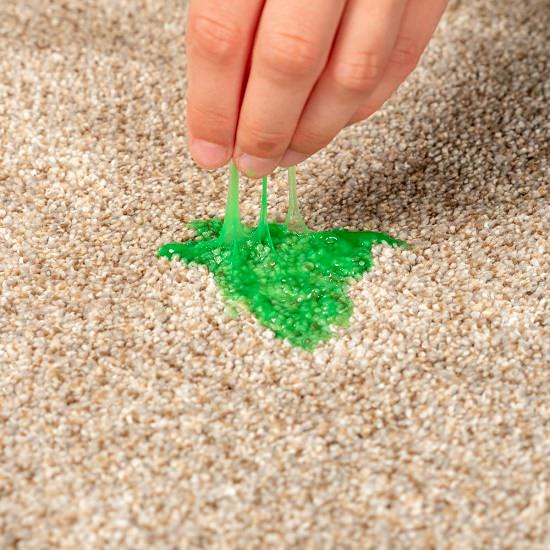Making and playing with slime at home has become a popular pastime for kids in the past few years, with hundreds of “influencers” online showing off their creations and talking about how to make your own. Unfortunately for parents, slime doesn’t always stay where it’s supposed to. Your child’s gooey playtime becomes another chore for you when it gets on the carpet or the upholstery of your couch. Thankfully, this doesn’t have to be an emergency. Slime stains can be removed just as well as many household stains, often with products you already have at home. Here’s some advice on cleaning up after your child’s adventures in slime-making.
What to Know Before You Begin
It’s important to know what you’re dealing with when cleaning a mess out of your carpet. If you didn’t personally help with the process and don’t know the recipe, custom-made slime typically uses glue—the kind used in arts and crafts projects for school—as a base, along with an additive that reacts with the glue to change its consistency. Everything else is just details, from food coloring to glitter. What this means is that cleaning agents effective on glue and other sticky adhesives should work for cleaning up slime as well.
What NOT to Use
Some DIY solutions offered for cleaning up stains from carpet can, in fact, make the situation worse, so it’s vital to get those out of the way so that you don’t end up regretting the whole project.
Certain cleaners are prone to leaving behind their own stains after use. Many people online, especially on lifehack blogs and videos, recommend WD-40 as a miracle cleaner for all sorts of nasty messes. However, the mineral oils that make WD-40 effective at dissolving adhesive stains can remain in the carpet, trapping dust and grime and refusing water-based cleaning. Any other oil-based cleaner is likely to result in this as well. Detergents, such as for laundry or dishes, can produce a sudsy mess that you then also have to clean up, and vinegar, while effective as an acidic cleaner, is rough on certain carpet materials when used at a high concentration.
Another thing to be careful about is being too abrasive. Some elbow grease is expected when removing slime, but too much can damage the carpet itself, fraying and tearing the fibers under the stain. Don’t overdo it while scrubbing away at the stain. If it’s not working, the answer is to try to loosen or break up the remaining residue rather than to simply scrub and scrape harder.
Initial Removal
Regardless of what you use, before you apply any kind of cleaner to the carpet, you need to remove as much of the slime as possible by hand. Ideally, this should be done while the slime is still wet—if it has time to dry, removing it will be a little more difficult, though still possible. There are a few ways of going about this, and it’s best to try more than one together to see better results.
Start by pulling up the slime out of the carpet—first with your bare hands, then using a scraping tool like a spoon, spatula or butter knife. Warm water may help loosen it as well, though slime is not water soluble and this won’t clear it away entirely. If the slime has dried into the carpet and you can’t quite pull it free, place some ice atop the stain and wait a few minutes for the slime to cool and harden. This should let you break it apart for easier scraping and removal. If necessary, a handheld vacuum can clear away residue as well.
If there’s no remaining slime at this point and no sign of staining or discoloration, your work is done. Otherwise, you’ll want to bring out some cleaning agents.
DIY Cleaner Options
Commercial household cleaners are effective in their own right, but some homeowners have concerns about health risks, especially to children and pets, or about potential damage to more sensitive carpet materials. Additionally, it’s helpful to have other products on hand that can double as carpet cleaners. In the case of cleaning up carpet stains caused by slime, some household options prove especially helpful.
- White vinegar is effective in cleaning sticky residue out of carpets because of its acidity, as long as you take some care with using it. Dilute it first by adding one part water for two parts vinegar, then put the mixture in a spray bottle and apply it to the stain. This should take effect quickly, especially after removing the bulk of the slime.
- Baking soda can be used together with white vinegar, also. The two react powerfully together, breaking up stains in the process. Be sure to clean up the area by blotting with a sponge and water afterwards.
- Club soda works as an alternative to vinegar that is less harsh, for carpets that you want to be careful with. It contains carbonic acid that breaks up slime residue. You shouldn’t need to mix it with water to dilute it, but you may need some extra scrubbing afterward.
- Isopropyl (rubbing) alcohol works as a potent solvent for materials that water cannot dissolve. Use a sponge or cloth to blot the stain with alcohol, rinsing it out occasionally, until the stain is clear. Test the alcohol on a small, discreet spot of the carpet first to make sure it won’t stain or discolor the fabric.
- Hydrogen peroxide, often used to clean and disinfect wounds, also reacts strongly with slime stains. Only use this on lighter fabrics, as hydrogen peroxide is a strong bleaching agent as well—if you’re unsure, do a spot test. Dry quickly after use to avoid damage.
Whatever you use as cleaner, apply a small amount at first and allow it to soak in before continuing. Use a scrub brush to work the cleaner into the slime stain and break it up more quickly, and blot the mixture with a white cloth or paper towel to remove fluid. Let the treated area air-dry afterward—how long this takes will depend on the cleaner used, but a couple hours will do for any of them.
Turning to Professionals
If the slime stain persists through your efforts, up to the point that you feel comfortable attempting, help is in order. At best, continuing to try the DIY method will just waste time, and at worst, it’ll damage the carpet. Safe-Dry Carpet Cleaning of Lexington is equipped with specialized cleaning solutions and tools, as well as trained experts, to draw out and erase stubborn stains, effectively and quickly. If you’re facing a stain that won’t give up, contact us to schedule an inspection and cleaning session today.




